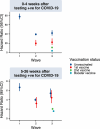Risk of death in England following a positive SARS-CoV-2 test: A retrospective national cohort study (March 2020 to September 2022)
- PMID: 39383163
- PMCID: PMC11463829
- DOI: 10.1371/journal.pone.0304110
Risk of death in England following a positive SARS-CoV-2 test: A retrospective national cohort study (March 2020 to September 2022)
Abstract
Background: We aimed to estimate the relative risk of mortality following a first positive SARS-CoV-2 test during the first, second, and third waves of the COVID-19pandemic in England by age, sex, and vaccination status, taking into account pre-existing health conditions and lifestyle factors.
Methods: We conducted a retrospective cohort study of all individuals registered with the National Health Service (NHS) in England from 1 March 2020 to September 2022. Data for all individuals were obtained and linked including primary care records, hospital admission episodes, SARS-CoV-2 test results, vaccinations, and death registrations. We fitted Cox Proportional Hazards models with time dependent covariates for confirmed SARS-CoV-2 infection to model the risk of subsequent mortality.
Results: The hazard ratio for death after testing positive for subsequent, compared with those not testing positive, amongst unvaccinated individuals, ranged from 11 to 89 by age and sex, in the first four weeks following a positive test in wave one and reduced to 14 to 50 in wave three. This hazard was further reduced amongst those who had three vaccines to between 1.4 and 7 in wave three.
Conclusions: This study provides robust estimates of increased mortality risk among those who tested positive over the first three waves of the COVID-19 pandemic in England. The estimates show the impact of various factors affecting the risk of mortality from COVID-19. The results provide the first step towards estimating the magnitude and pattern of mortality displacement due to COVID-19, which is essential to understanding subsequent mortality rates in England.
Copyright: © 2024 Bauer-Staeb et al. This is an open access article distributed under the terms of the Creative Commons Attribution License, which permits unrestricted use, distribution, and reproduction in any medium, provided the original author and source are credited.
Conflict of interest statement
PG declares consultancy payments made from OHID to UCL Consulting to support the preparation of this manuscript. All other authors have no declarations.
Figures



References
-
- Department of Health and Social Care. Excess mortality in England and English regions. In: GOV.UK [Internet]. 9 Mar 2023. [cited 18 Mar 2023]. Available: https://www.gov.uk/government/statistics/excess-mortality-in-england-and...
-
- Clift AK, Coupland CAC, Keogh RH, Diaz-Ordaz K, Williamson E, Harrison EM, et al.. Living risk prediction algorithm (QCOVID) for risk of hospital admission and mortality from coronavirus 19 in adults: national derivation and validation cohort study. BMJ. 2020;371: m3731. doi: 10.1136/bmj.m3731 - DOI - PMC - PubMed
MeSH terms
LinkOut - more resources
Full Text Sources
Medical
Miscellaneous

